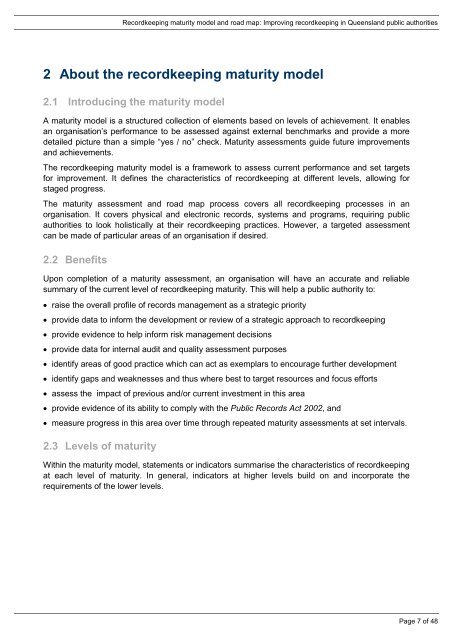Recordkeeping maturity model and road map
2amfjio
2amfjio
You also want an ePaper? Increase the reach of your titles
YUMPU automatically turns print PDFs into web optimized ePapers that Google loves.
<strong>Recordkeeping</strong> <strong>maturity</strong> <strong>model</strong> <strong>and</strong> <strong>road</strong> <strong>map</strong>: Improving recordkeeping in Queensl<strong>and</strong> public authorities<br />
2 About the recordkeeping <strong>maturity</strong> <strong>model</strong><br />
2.1 Introducing the <strong>maturity</strong> <strong>model</strong><br />
A <strong>maturity</strong> <strong>model</strong> is a structured collection of elements based on levels of achievement. It enables<br />
an organisation’s performance to be assessed against external benchmarks <strong>and</strong> provide a more<br />
detailed picture than a simple “yes / no” check. Maturity assessments guide future improvements<br />
<strong>and</strong> achievements.<br />
The recordkeeping <strong>maturity</strong> <strong>model</strong> is a framework to assess current performance <strong>and</strong> set targets<br />
for improvement. It defines the characteristics of recordkeeping at different levels, allowing for<br />
staged progress.<br />
The <strong>maturity</strong> assessment <strong>and</strong> <strong>road</strong> <strong>map</strong> process covers all recordkeeping processes in an<br />
organisation. It covers physical <strong>and</strong> electronic records, systems <strong>and</strong> programs, requiring public<br />
authorities to look holistically at their recordkeeping practices. However, a targeted assessment<br />
can be made of particular areas of an organisation if desired.<br />
2.2 Benefits<br />
Upon completion of a <strong>maturity</strong> assessment, an organisation will have an accurate <strong>and</strong> reliable<br />
summary of the current level of recordkeeping <strong>maturity</strong>. This will help a public authority to:<br />
raise the overall profile of records management as a strategic priority<br />
provide data to inform the development or review of a strategic approach to recordkeeping<br />
provide evidence to help inform risk management decisions<br />
provide data for internal audit <strong>and</strong> quality assessment purposes<br />
identify areas of good practice which can act as exemplars to encourage further development<br />
identify gaps <strong>and</strong> weaknesses <strong>and</strong> thus where best to target resources <strong>and</strong> focus efforts<br />
assess the impact of previous <strong>and</strong>/or current investment in this area<br />
provide evidence of its ability to comply with the Public Records Act 2002, <strong>and</strong><br />
measure progress in this area over time through repeated <strong>maturity</strong> assessments at set intervals.<br />
2.3 Levels of <strong>maturity</strong><br />
Within the <strong>maturity</strong> <strong>model</strong>, statements or indicators summarise the characteristics of recordkeeping<br />
at each level of <strong>maturity</strong>. In general, indicators at higher levels build on <strong>and</strong> incorporate the<br />
requirements of the lower levels.<br />
Page 7 of 48


